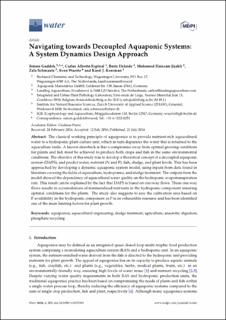Please use this identifier to cite or link to this item:
https://doi.org/10.21256/zhaw-3672Full metadata record
| DC Field | Value | Language |
|---|---|---|
| dc.contributor.author | Goddek, Simon | - |
| dc.contributor.author | Espinal, Carlos A. | - |
| dc.contributor.author | Delaide, Boris | - |
| dc.contributor.author | Jijakli, Haissam M. | - |
| dc.contributor.author | Schmautz, Zala | - |
| dc.contributor.author | Wuertz, Sven | - |
| dc.contributor.author | Keesman, Karel J. | - |
| dc.date.accessioned | 2018-05-17T14:13:47Z | - |
| dc.date.available | 2018-05-17T14:13:47Z | - |
| dc.date.issued | 2016 | - |
| dc.identifier.issn | 2073-4441 | de_CH |
| dc.identifier.uri | https://digitalcollection.zhaw.ch/handle/11475/5953 | - |
| dc.description.abstract | The classical working principle of aquaponics is to provide nutrient-rich aquacultural water to a hydroponic plant culture unit, which in turn depurates the water that is returned to the aquaculture tanks. A known drawback is that a compromise away from optimal growing conditions for plants and fish must be achieved to produce both crops and fish in the same environmental conditions. The objective of this study was to develop a theoretical concept of a decoupled aquaponic system (DAPS), and predict water, nutrient (N and P), fish, sludge, and plant levels. This has been approached by developing a dynamic aquaponic system model, using inputs from data found in literature covering the fields of aquaculture, hydroponics, and sludge treatment. The outputs from the model showed the dependency of aquacultural water quality on the hydroponic evapotranspiration rate. This result can be explained by the fact that DAPS is based on one-way flows. These one-way flows results in accumulations of remineralized nutrients in the hydroponic component ensuring optimal conditions for the plants. The study also suggests to size the cultivation area based on P availability in the hydroponic component as P is an exhaustible resource and has been identified one of the main limiting factors for plant growth. | de_CH |
| dc.language.iso | en | de_CH |
| dc.publisher | MDPI | de_CH |
| dc.relation.ispartof | Water | de_CH |
| dc.rights | https://creativecommons.org/licenses/by/4.0/ | de_CH |
| dc.subject.ddc | 630: Landwirtschaft | de_CH |
| dc.title | Navigating towards decoupled aquaponic systems : a system dynamics design approach | de_CH |
| dc.type | Beitrag in wissenschaftlicher Zeitschrift | de_CH |
| dcterms.type | Text | de_CH |
| zhaw.departement | Life Sciences und Facility Management | de_CH |
| zhaw.organisationalunit | Institut für Umwelt und Natürliche Ressourcen (IUNR) | de_CH |
| dc.identifier.doi | 10.21256/zhaw-3672 | - |
| dc.identifier.doi | 10.3390/w8070303 | de_CH |
| zhaw.funding.eu | No | de_CH |
| zhaw.issue | 7 | de_CH |
| zhaw.originated.zhaw | Yes | de_CH |
| zhaw.publication.status | publishedVersion | de_CH |
| zhaw.volume | 8 | de_CH |
| zhaw.publication.review | Peer review (Publikation) | de_CH |
| zhaw.webfeed | Ökotechnologie | de_CH |
| Appears in collections: | Publikationen Life Sciences und Facility Management | |
Files in This Item:
| File | Description | Size | Format | |
|---|---|---|---|---|
| water-08-00303.pdf | 2.49 MB | Adobe PDF |  View/Open |
Show simple item record
Goddek, S., Espinal, C. A., Delaide, B., Jijakli, H. M., Schmautz, Z., Wuertz, S., & Keesman, K. J. (2016). Navigating towards decoupled aquaponic systems : a system dynamics design approach. Water, 8(7). https://doi.org/10.21256/zhaw-3672
Goddek, S. et al. (2016) ‘Navigating towards decoupled aquaponic systems : a system dynamics design approach’, Water, 8(7). Available at: https://doi.org/10.21256/zhaw-3672.
S. Goddek et al., “Navigating towards decoupled aquaponic systems : a system dynamics design approach,” Water, vol. 8, no. 7, 2016, doi: 10.21256/zhaw-3672.
GODDEK, Simon, Carlos A. ESPINAL, Boris DELAIDE, Haissam M. JIJAKLI, Zala SCHMAUTZ, Sven WUERTZ und Karel J. KEESMAN, 2016. Navigating towards decoupled aquaponic systems : a system dynamics design approach. Water. 2016. Bd. 8, Nr. 7. DOI 10.21256/zhaw-3672
Goddek, Simon, Carlos A. Espinal, Boris Delaide, Haissam M. Jijakli, Zala Schmautz, Sven Wuertz, and Karel J. Keesman. 2016. “Navigating towards Decoupled Aquaponic Systems : A System Dynamics Design Approach.” Water 8 (7). https://doi.org/10.21256/zhaw-3672.
Goddek, Simon, et al. “Navigating towards Decoupled Aquaponic Systems : A System Dynamics Design Approach.” Water, vol. 8, no. 7, 2016, https://doi.org/10.21256/zhaw-3672.
Items in DSpace are protected by copyright, with all rights reserved, unless otherwise indicated.